|
General "Stonewall" Jackson
(1824-1863)
| General "Stonewall" Jackson |
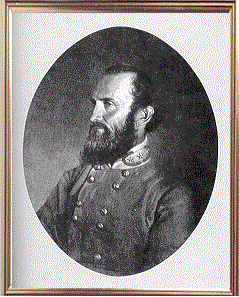
|
| General "Stonewall" Jackson |
GENERAL "STONEWALL" JACKSON
"There is Jackson standing like a stone wall! Rally
behind the Virginians!" Brig. Gen. Barnard Elliott Bee referring to General "Stonewall"Jackson during the First Battle of Manassas (also known as First Bull Run.)
| General Stonewall Jackson |
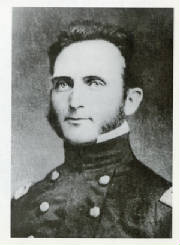
|
| (Click to Enlarge) |
By defeating the Union army at Bull Run, Jackson's brigade was
henceforth known as the Stonewall Brigade. At Manassas, Jackson's brigade had suffered more casualties
than any other Southern brigade. Historians have long since debated the remarks of Gen. Barnard Bee; in particular the words
"stone wall." Jackson's stalwart performance at Bull Run, however, reflected and defined Bee's remarks. Bee had
exclaimed: "Rally behind the Virginians!" Why? Because the Virginians had held the ground. Jackson was
a general that was steadfast, tenacious and even ferocious in battle, and had previously performed "valiantly during
the Mexican War." Thomas "Stonewall" Jackson's subsequent performances in Civil War battles also strongly underscore this
position. In legal terms, Jackson's valor during the Mexican War and at First Manassas
is referred to as precedent.
(Right) Photograph of Major Jackson in 1851, shortly before he left
Army service. That same year, he resigned his commission and began teaching at the Virginia Military Institute. Courtesy
VMI.
Next to General Robert E. Lee, General "Stonewall" Jackson is the most revered of all Confederate
commanders.
| General Stonewall Jackson |
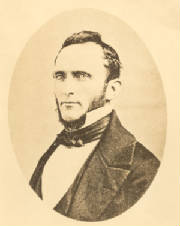
|
| (Click to Enlarge) |
(Left) Jackson sat for this portrait in 1855, when he was living in Lexington,
Virginia and teaching at VMI. Courtesy VMI.
Upon the outbreak of the Civil
War, he was commissioned a colonel in the Virginia forces and dispatched to Harpers Ferry where he was active in organizing
the raw recruits until relieved by Joe Johnston. His later assignments included: commanding 1st Brigade, Army of the Shenandoah
(May - July 20, 1861); brigadier general, CSA (June 17, 1861); commanding 1st Brigade, 2nd Corps, Army of the Potomac (July
20 - October 1861); major general, CSA (October 7, 1861); commanding Valley District, Department of Northern Virginia (November
4, 1861 - June 26, 1862); commanding 2nd Corps, Army of Northern Virginia (June 26, 1862-May 2, 1863); and lieutenant general,
CSA (October 10, 1862).
Leaving Harpers Ferry, his brigade moved with Johnston
to join Beauregard at Manassas. In the fight at 1st Bull Run, they were so distinguished that both the brigade and its commander
were dubbed "Stonewall" by General Barnard Bee. The 1st Brigade was the only Confederate brigade to have its nickname become
its official designation. That fall, Jackson was given command of the Valley with a promotion to major general.
| General Stonewall Jackson |
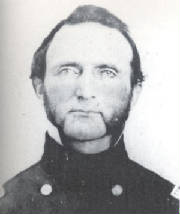
|
| (Click to Enlarge) |
(Right) Professor Jackson, 1857. Copy from an ambrotype attributed to Lexington (VA) photographer Samuel
Pettigrew. Courtesy VMI.
That winter, he launched a dismal campaign into the western part of the state that resulted in a long feud
with General William Loring and caused Jackson to submit his resignation; subsequently, he was persuaded not to resign.
In March he launched an attack on what he thought was a Union rear guard at Kernstown. Faulty intelligence from his cavalry
chief, Turner Ashby, led to a defeat. A religious man, Jackson always regretted having fought on a Sunday (although many of
Jackson's victories occurred on that day). But the defeat had the desired result, halting reinforcements being sent to McClellan's
army from the Valley. In May, Jackson defeated Fremont's advance at McDowell and later that month launched a brilliant campaign
that kept several Union commanders in the area off balance. He won victories at Front Royal, 1st Winchester, Cross Keys, and
Port Republic. He then joined Lee in the defense of Richmond but displayed a lack of vigor during the Seven Days.
Detached from Lee, he advanced to the north to engage John Pope's army and after a slipshod battle at Cedar Mountain, slipped
behind Pope and captured his Manassas junction supply base. He then hid along an incomplete branch railroad and awaited Lee
and Longstreet. Attacked before they arrived, he held on until Longstreet could launch a devastating attack which brought
a Second Bull Run victory.
In the invasion of Maryland,
Jackson was detached to capture Harpers Ferry and was afterwards distinguished at Antietam with Lee. He was promoted after
this and given command of the now-official 2nd Corps. Previously, it had been known as a wing or command. He was disappointed
with the victory at Fredericksburg because it could not be followed up. In Jackson's greatest day, he led his corps around
the Union right flank at Chancellorsville and routed the 11th Corps. Reconnoitering that night, he was returning to his
own lines when he was mortally wounded by some of his own men.
| General "Stonewall" Jackson Memorial |
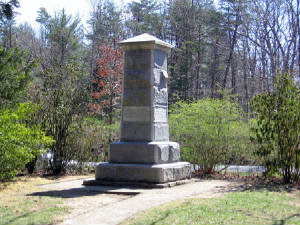
|
| Courtesy of the National Park Service |
Following the amputation of his arm, he died eight days later on May 10,
1863, from pneumonia. Lee wrote of him with deep feeling: "He has lost his left arm; but I have lost my right arm." A superb
commander, Jackson has been criticized. Personnel problems haunted him, as in the feuds with Loring and with Garnett after
Kernstown. His choices for promotion were often not first rate. He did not give his subordinates enough latitude, which denied
them the training for higher positions under Lee's loose command style. This was especially devastating in the case of his
immediate successor, Richard Ewell. Although he was sometimes balky when in a subordinate position, Jackson was supreme on
his own hook. General "Stonewall" Jackson is buried in Lexington, Virginia, and his grave is visited by tens-of-thousands
each year.
"Let us cross over the river and rest under the shade of the trees."
Final words of General "Stonewall" Jackson
(About) Video of General "Stonewall" Jackson earning his nom de guerre in Civil War Battle of
Bull Run.
Sources: Official Records of the Union and Confederate Armies; Stewart Sifakis, Who Was Who in the Civil
War.
Recommended Reading:
Stonewall Jackson: The Man, the Soldier, the Legend (Hardcover) (950 pages).
Description: A distinguished Civil War historian unravels
the complex character of the Confederacy's greatest general. Drawing on previously untapped manuscript sources, the author
refutes such long-standing myths as Stonewall Jackson's obsessive eating of lemons and gives a three-dimensional account of
the profound religious faith frequently caricatured as grim Calvinism. Though the author capably covers the battles that made
Jackson a legend--Sharpsburg, Fredericksburg, etc.--he emphasizes "the life story of an extraordinary man." The result
is a biography that will fascinate even those allergic to military history. Continued below.
The New York
Times Book Review, Stephen W. Sears . . . [T]wo dozen writers have attempted [Stonewall] biographies, and there are any number
of special studies, monographs and essays. Now going straight to the head of the class of Jackson biographers,
and likely to remain there, is James I. Robertson Jr. . . . Stonewall Jackson:
The Man, the Soldier, the Legend gives us far and away the sharpest picture we have ever had of this enigmatic
figure. "[A] must have for the Civil War buff and for anyone remotely interested in General "Stonewall" Jackson."
See also:
Recommended Reading: Four Years in the Stonewall Brigade
(American Civil War Classics) (412 pages) (University of South Carolina Press). Description: From his looting of farmhouses during the Gettysburg campaign and robbing of fallen Union soldiers as
opportunity allowed to his five arrests for infractions of military discipline and numerous unapproved leaves, John O. Casler’s
actions during the Civil War made him as much a rogue as a Rebel. Though he was no model soldier, his forthright confessions
of his service years in the Army of Northern Virginia stand among the most sought after and cited accounts by a Confederate
soldier. First published in 1893 and significantly revised and expanded in 1906, Casler’s Four Years in the Stonewall
Brigade recounts the truths of camp life, marches, and combat. Moreover, Casler’s recollections provide an unapologetic
view of the effects of the harsh life in Stonewall’s ranks on an average foot soldier and his fellows. Continued below.
A native of
Gainesboro,
Virginia, with an inherent wanderlust and thirst for adventure, Casler enlisted in June 1861
in what became Company A, 33rd Virginia Infantry, and participated in major campaigns throughout the conflict, including Chancellorsville
and Gettysburg. Captured in February 1865, he spent the final
months of the war as a prisoner at Fort McHenry, Maryland. His postwar narrative recalls the realities of warfare for the private soldier, the moral ambiguities of thievery
and survival at the front, and the deliberate cruelties of capture and imprisonment with the vivid detail, straightforward
candor, and irreverent flair for storytelling that have earned Four Years in the Stonewall Brigade its place in the first
rank of primary literature of the Confederacy. This edition features a new introduction by Robert K. Krick chronicling Casler’s
origins and his careers after the war as a writer and organizer of Confederate veterans groups. "A must have for researchers,
buffs, and American historians...General "Stonewall" Jackson and his brigade shall forever have a place in the annals
of world history."
Recommended
Reading: Stonewall Jackson's Book of Maxims (Hardcover). Description: Stonewall Jackson's Book of Maxims is inspiring
to say the least. Thomas Jackson was raised as an orphan in the mountains of [West] Virginia, had less than a fourth-grade
education when he entered West Point and then catapulted himself as an elite strategist/tactician and general of the
Civil War. Thought to be obsessive, eccentric, and unable to chat at social events....Jackson hid from the world a man
that he hoped to be someday. That other Jackson, however, comes screaming just like his famous bloodcurdling rebel yell.
Continued below.
"You may be what ever you will resolve to be" is etched over an archway at the Virginia
Military Institute where he was also a professor. His works were saved, lost, and thankfully found again... "A truly inspiring
work." "[A] must have for anyone remotely interested in General "Stonewall" Jackson, the Civil War, and American history."
Recommended Reading: Stonewall in
the Valley: Thomas J. Stonewall Jackson's Shenandoah Valley Campaign, Spring 1862. Description:
The Valley Campaign conducted by Maj. Gen. Thomas J. "Stonewall" Jackson has long fascinated those interested in the American
Civil War as well as general students of military history, all of whom still question exactly what Jackson did in the Shenandoah in 1862 and how he did it. Since Robert G. Tanner answered
many questions in the first edition of Stonewall in the Valley in 1976, he has continued to research the campaign. This
edition offers new insights on the most significant moments of Stonewall's Shenandoah triumph. Continued below.
About the Author: Robert G. Tanner is a graduate of the Virginia Military Institute. A native of Southern California,
he now lives and practices law in Atlanta, Georgia.
He has studied and lectured on the Shenandoah Valley Campaign for more than twenty-five years.
Recommended Viewing:
Still Standing: The Stonewall Jackson Story, starring James I Robertson Jr., Bill Potter, and Ken Carpenter (2007) (DVD). Description: His legacy as a military genius is widely renowned. Now,
in Still Standing: The Stonewall Jackson Story, his legacy as a man of resolute Christian character is captured in this revealing
documentary. Through stunning High Definition videography and expert narrative, Still Standing traces the life of Stonewall
Jackson from his orphaned childhood, to the Sunday School class he taught for African Americans that has resulted in a lasting
impact today, to the pivotal role he played as a General in the Civil War. Still Standing inspires, entertains, and educates
as it examines the life of a uniquely American hero. Continued below.
Review: In true Franklin Springs Family Media fashion, Still Standing: The Stonewall Jackson
Story is destined to become a family favorite. Still Standing chronicles the life of a true Christian man brought to fame
by his exemplary military acumen in the American Civil War. But it was his faithfulness to the Gospel in his family, with
his children, toward his soldiers, and the Sunday School class for Blacks (freemen and slaves) that he started, taught, and
supported that, no doubt, earned Thomas Jackson the reward of hearing those precious words, Well done, good and faithful servant,
from his King when he crossed over the river and finally rested under the shade of the trees. This important documentary will
be used in my family to inspire a new generation to look to General Jackson as a man with flaws, but who followed hard after
Christ. May mine and I, by God s grace, stand like a stone wall before the onslaught of the enemy, trusting that we are as
safe on the battlefield as we are in our beds. --Home Schooling Today
Recommended
Viewing: Biography - Stonewall Jackson (2005) (A&E) (DVD). Description: He earned his nickname for
bravery at Bull Run and led some of the most stunning campaigns of the Civil
War. An outstanding leader and brilliant tactician, Stonewall Jackson is widely regarded as one of the greatest Confederate
commanders. In an exhaustive investigation, this documentary examines Jackson's
military prowess through period accounts, interviews with renowned Civil War historians and military experts, and Jackson's
own strategies in his pivotal engagements. Continued below.
Follow his
career through the American Army, the Mexican American War, and his command in the Confederacy. See rare photos of the famed
leader and learn the tragic story of his death at Chancellorsville. Stonewall
Jackson visits some of the bloodiest battlegrounds in America for a riveting portrait of the commander
who held his ground “like a stone wall.”
Recommended Reading: Rebels
from West Point: The 306 U.S. Military
Academy Graduates Who Fought for the Confederacy.
Description: "Rebels from West Point" tells the story of the 306 officers who, after receiving a West Point education and
swearing to uphold the values of the Union, defected to serve the Confederacy. Continued below.
The author examines this fascinating
group of officers, describing the heart-wrenching choice they made and how, even after they "went South," they remained connected
to the brotherhood of their former West Point cadets. Among the more famous personalities included in this group are Gen. Robert E. Lee,
Gen. Thomas J. "Stonewall" Jackson, Gen. J. E. B. Stuart, Gen. A. P. Hill, Gen. James Longstreet, and Gen. John B. Hood.
|

